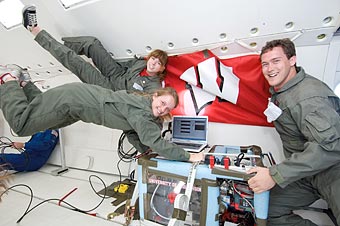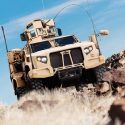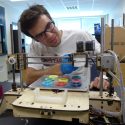Zero-gravity team finds spray cooling works in space
For the 10th consecutive year, UW–Madison students have found themselves floating upside down over the Gulf of Mexico.

Engineering students and ZeroG team members (from left to right) Lisa McGill, Jessica Rybicki and Adam Beardsley experience near-weightlessness during their April experiment with the NASA Reduced Gravity Student Program, which allows students to propose, design and test an experiment of their choice in varying gravity conditions.
Seven students from the UW-Madison ZeroG team spent a week in April at the NASA Johnson Space Center in Houston, participating in the annual NASA Reduced Gravity Student Program, which allows students to propose, design and test an experiment of their choice in varying gravity conditions.
The results from the UW–Madison experiment show a particular spray cooling method is not dependent on gravity — a significant finding that means spray cooling could be used in airplane and other high-heat electronics.
The experiment was based on the work of team adviser and mechanical engineering Associate Professor Timothy Shedd.
Circuits on a computer chip have temperature-dependent performances — when chips get too hot, they slow down. Air-cooling methods, which use fans to blow air across the chips, are not ideal for supercomputers or large server banks, such as the racks of computers that support Yahoo or many financial institutions.
Shedd and his team have developed a system that sprays dielectric liquid in a linear array directly onto the chips. The liquid won’t damage the electronics, and the direct contact maximizes the amount of heat transferred from the chip to the liquid.
Traditional spray cooling methods direct the liquid upward, relying on gravity to drain the liquid away. However, this method won’t work in laptops since users move the computer in many directions. The method also won’t work in airplanes or spacecraft, which go through varying gravity conditions.
“To be reliable, spray cooling has to not be gravity dependent,” Shedd says. Shedd thought his linear spray array could be the answer, but testing was difficult.
That’s where ZeroG came in.
The team spent the winter designing and building the experiment, resulting in a 12-cubic-square-foot Plexiglas box capable of videotaping the spray and measuring how well it cools electronics.
The team was in Houston from April 17 through 25 and allowed two flights on the “Weightless Wonder,” a C-9 aircraft that flies in a parabola. The plane creates a 30-second period of weightlessness at its peak and a 60 second period of double gravity when it dips and ascends again to the next peak.
The transition between the double gravity and zero gravity periods is difficult for some passengers-the team was kindly forewarned that a third of passengers are fine on the flight, another third get sick and the final third get violently sick without anti-nausea medication.
However, the five UW–Madison students who flew were more than fine. “When you get to the point of realizing, man, we’re really doing this, it blows your mind,” says engineering mechanics and astronautics undergraduate John Springmann.
The plane makes multiple passes over the Gulf of Mexico. In addition to the spray cooling experiment, the students tested what their bodies could do in zero gravity as the plane went up and down.
Physics and mathematics student Adam Beardsley wandered around on the ceiling. Since blood doesn’t rush to the brain while upside down in zero gravity, he felt normal-the others looked like they were the ones upside down.
When the plane landed, the trip wasn’t over. The students toured historic mission control, sitting in the chairs that belonged to scientists from the original Apollo missions in the 1960s. They walked through a life-size mock-up of the International Space Station and watched as astronauts trained in giant swimming pools.
Back in Wisconsin, the students still have plenty of work to do. Team members will try publishing their research and will speak to a variety of groups ranging from elementary classrooms to the Wisconsin Space Conference in August.
Two team members are active with NASA this summer. Springmann is participating in the NASA Academy, a residential internship program in Greenbelt, Md., that allows students to conduct laboratory research.
Lisa McGill, an engineering mechanics and astronautics undergraduate, is working on Web technology at the NASA Ames Research Center at Moffett Field, Cal., as part of the Education Associates Program.
For Shedd, the ZeroG team provided valuable data. The team found that linear spray cooling is effective in both zero gravity and double gravity conditions.
“I thought they did a nice job-this experiment is hard enough to do on the ground, much less in a container they’ve shipped to Houston and put on a plane,” he says.
Tags: business, engineering, student life



